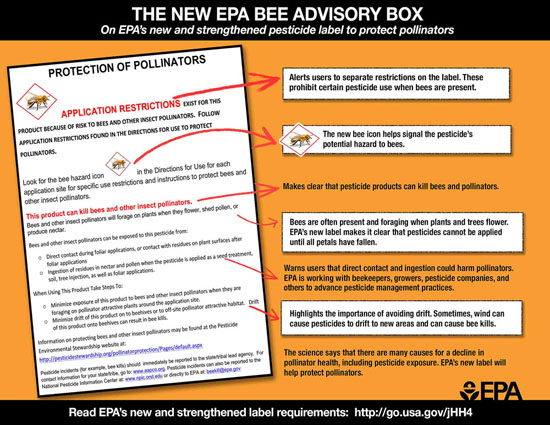Issue 16, September 23, 2013
New Pesticide Labeling for Bee Protection
The U.S. Environmental Protection Agency (EPA) instituted new pesticide labeling requirements on August 15, 2013 to better protect honey bees and other pollinators. Recent research on the honey bee, bumblebees, and other insect pollinators have shown that pesticide use is partially involved in colony collapse disorder (CCD) of honey bees and the decline of other pollinating insects. There have also been several off-label applications of the insecticide dinotefuran, particularly in Oregon, that have drawn attention to this issue.
The neonicotinoid insecticides imidacloprid, thiamethoxam, clothianidin, and dinotefuran, have received the most attention. Imidacloprid, thiamethoxam, and clothianidin move systemically through the plant and into the pollen. Pollen is collected by foraging honey bees, carried back to the hive, and fed to the larvae in the colony. This has been shown to cause severe hive reductions as well as affect the ability of the adult bees to function.
Other insecticides are important as well. Carbaryl dust, wettable powder, and liquid formulations have long been known to affect honey bee hives. In recent years, formulations containing more finely ground particles of this insecticide have greatly reduced this concern. Microencapsulated formulations of insecticides are also deleterious to honey bees. The microcapsules and the older carbaryl formualtions were the correct size to be confused as pollen by foraging honey bees. In recent years, the particle sizes of several microencapsulate formulations have been changed to reduce this problem.
Recently, research studies have shown links between some fungicide applications and honey bee reductions. Honey bees, like us and other animals, use microorganisms within their guts to help digest their food. Fungicide applications have been linked to a die-off of these beneficial microorganisms in the digestive systems of honey bees, resulting in reduced fitness and increased mortality.
Insect pollinators include not only the honey bee, but also many other species including bumblebees, carpenter bees, alkali bees, leafcutter bees, and other bees. In addition, wasps, many flies, butterflies, moths, and numerous beetles are important pollinators. Besides insects, hummingbirds and bats are important pollinators in the U.S.
The EPA has developed new pesticide labels that prohibit use of some neonicotinoid pesticide products where bees are present. The new labels will have a bee advisory box and icon with information on routes of exposure and spray drift precautions. See the accompanying figure for the bee advisory box with explanation of its content. The label change affects products containing the neonicotinoids imidacloprid, dinotefuran, clothianidin and thiamethoxam. The EPA will work with pesticide manufacturers to change labels so that they will meet the Federal Insecticide, Fungicide, and Rodenticide Act (FIFRA) safety standard.

Click the photo for a larger version.
In May, the U.S. Department of Agriculture (USDA) and EPA released a comprehensive scientific report on honey bee health, showing scientific consensus that there are a complex set of stressors associated with honey bee declines, including loss of habitat, parasites and disease, genetics, poor nutrition and pesticide exposure.
EPA continues to work with beekeepers, growers, pesticide applicators, pesticide and seed companies, and federal and state agencies to reduce pesticide drift dust and advance best management practices. The EPA recently released new enforcement guidance to federal, state and tribal enforcement officials to enhance investigations of beekill incidents. (Phil Nixon with portions from an EPA news release)
Author:
Phil Nixon